![]()
![]()
![]()
Use LEFT and RIGHT arrow keys to navigate between flashcards;
Use UP and DOWN arrow keys to flip the card;
H to show hint;
A reads text to speech;
15 Cards in this Set
- Front
- Back
|
This arch is a combination of features. The circular disks come from ancient rome, and represents the mode of reverting to antiquity. It is a combination of stuff.
|
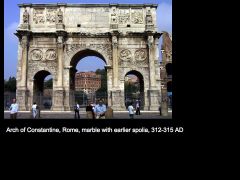
Arch of Constantine
|
|
|
Largess of Constantine, 312 CE.
Represents constantine giving booty to his followers. the round. Doesn't explain the Ambitions of the Moment. Details fo constantine --same scale, no spatial reality, or movement, or repetition. no variety. Represents constantine as the central order of the law. |

Largess of Constantine
|
|
|
porphyry, c 300 CE. 2 eastern and two western reps. Once stood in Istanbul. Squat and reduced to abstraction, unrealistic. An allegory of the empire's insecurity. Human being's confidence now lies at the mercy of events, lack of confidence in human abilities. Inner reality-spiritual power more important than external.
|

tetrarchs. Porphyry. c. 300 CE.
|
|
|
Narthex-entry way. peter was thought to have been buried at this site, buried under, ancient roman cemetary under basilica.
|
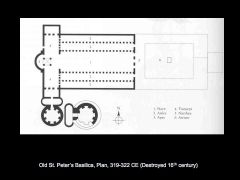
old basilica Plan of St. Peter's.
Nave ofr congregation, altar, apse, where the priest celebrated Eucharist. |
|
|
The Old basilica was used for secular purposes-such as a law court. There was a nave without aisles, but also an apse-emperor may have been enthroned here. Roman temples couldn't suit the congregational nature of christianity but these basilicas or law courts could. Things that he changed were the addition of barrel vaulted ceilings, rather than the wood ones depicted here-to make it fire proof.
|

The Old Basilica
|
|
|
Santa Costanza. 350. Central plan with an ambulatory around. tradition of mausoleum dedicated in this form, in order to represent the relics that would have been buried here. However, it reflects the death and ressurection of christ.
|

Santa Costanza, 350.
|
|
|
the light ame in from the windows surrounding the altar in the center. Purity ingeometirc form. barrel vaulted ceilings, mosaics traditionally for floors during roman era-set in cement and plaster, now used on walls and ceilings.
|

interior of Santa Costanza
|
|
|
ceiling mosaic of Santa Costanza
|
Ceiling mosaic. figural symbolism of wine making-represents humanity, but at the same time is an allegory of the blood of christ-sacrifice for humanity.
|
|
|
hercules figures in burial chamber, Via Latina catacomb, Hercules Leading Alcestis out of Hades. 350-400
|
wealthy families had rooms dug underground-filled with hercules figures. Hercules although a pagan figure, becomes figure of christ, his labors represent the ways in which christ triumphed over death.
|
|
|
This is a clear reference to the bible. analogy between christ and the shepherd, suggesting his power and compassion. a fear of representing god himself so storeis allegories are used to reference in roundabout ways.
|
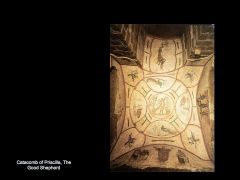
Catacomb of Priscilla, the Good Shepherd.
|
|
|
undistinguished outside, but interior all walls decorated in mostaic. the soul or interior matters. an allegory of faith. The symbols of the four evangelists.
|
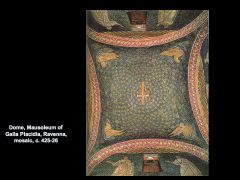
Mausoleum of Galla Placidia, Dome. Ravenna. c 425-426
|
|
|
425-428
this mosaic filled once side of the building. transitional figure, fusion of shepherd with christ itself. new god. now has halo and cross instead of a crook. elaborate purple robe suggests imperial status of a spiritual emperor. progression of iconography. change in representation of christ. |
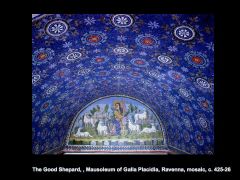
Good shepherd Mosaic in the Mausoleum of Galla Placidia.
|
|
|
circular plan with a simple interior covered in mosaics. central plan once attached toa palace, apse projects to one side, off center.
|

plan of san vitale, in ravenna. 530-547.
|
|
|
530-547 ce. all surfaces inside covered with mosaic. the apse-or alter head has an image of christ as the ruler, richly ornamened with life of its own. christ is depicted as the ruler of the universe. good shepherd is gone.
|

interior of san vitale. 530-547 ce.
|
|
|
christ depictd as ruler of universe.
|
gold ground, holy terrain. christ depicted as ruler of universe. inauguration of christian iconography. imagination of context, perspefctive, spiritual sginficance is most important-an abstraction. dominion of earth depictd through christ sitting on the world.
|

